Oval Office

The Oval Office is the official office of the President of the United States. It is located in the West Wing of the White House Complex.
The room features three large south-facing windows behind the president's desk, and a fireplace at the north end. It has four doors: the east door opens to the Rose Garden; the west door leads to a private study and dining room; the northwest door opens onto the main corridor of the West Wing; and the northeast door opens to the office of the president's secretary.
Presidents generally decorate the office to suit their personal taste, choosing new furniture, new drapery, and designing their own oval-shaped carpet to take up most of the floor. Artwork is selected from the White House's own collection, or borrowed from museums for the president's term in office.
Cultural history
The Oval Office has become associated in Americans' minds with the presidency itself through memorable images, such as a young John F. Kennedy, Jr. peering through the front panel of his father's desk, President Richard Nixon speaking by telephone with the Apollo 11 astronauts during their moonwalk, and daughter Amy Carter bringing her Siamese cat Misty Malarky Ying Yang to brighten President Jimmy Carter's day.
Oval Office Addresses
An Oval Office Address, the television broadcast of a formal presidential speech from the office, is rare and reserved for occasions with a sense of gravity, such as when President Kennedy presented news of the Cuban Missile Crisis, or President Richard Nixon announced his resignation on August 8, 1974, or President Ronald Reagan addressed the nation following the Space Shuttle Challenger Disaster, or President George W. Bush addressed the nation on the evening of September 11, 2001.
Antecedents
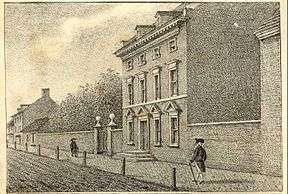
Washington's Bow Window
George Washington never occupied the White House. He spent most of his presidency in Philadelphia, Pennsylvania, which served as the temporary national capital for 10 years, 1790–1800, while Washington, D.C. was under construction.
In 1790, Washington built a large, two-story, semi-circular addition to the rear of the President's House in Philadelphia, creating a ceremonial space in which the public would meet the President.[1] Standing before the three windows of this Bow Window, he formally received guests for his Tuesday afternoon levees, delegations from Congress and foreign dignitaries, and the general public at open houses on New Year's Day, the Fourth of July, and his birthday.
"Washington received his guests, standing between the windows in his back drawing-room. The company, entering a front room and passing through an unfolding door, made their salutations to the President, and turning off, stood on one side."[2]
The apsidal end of a room was a traditional site of honor, for a host, a potentate, or the magistrate in a basilica.
President John Adams occupied the Philadelphia mansion beginning in 1797, and used the Bow Window in the same manner as his predecessor for the first three years of his presidency.[3]
Curved foundations of Washington's Bow Window were uncovered during a 2007 archaeological excavation of the President's House site.[4][5]
White House
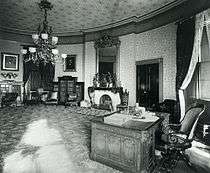
Architect James Hoban visited President Washington in Philadelphia in June 1792 and would have seen the Bow Window.[6] The following month, he was named winner of the design competition for The White House.
The "elliptic salon" at the center of the White House was the outstanding feature of Hoban's original plan. An oval interior space was a Baroque concept that was adapted by Neoclassicism. Oval rooms became popular in eighteenth century neoclassical architecture.
In November 1800, John Adams became the first President to occupy the White House. He and his successor, President Thomas Jefferson, used Hoban's oval rooms in the same ceremonial manner that Washington had used the Bow Window, standing before the three windows at the south end to receive guests.[7]
During the 19th century, a number of presidents used the White House's second-floor Yellow Oval Room as a private office or library.
West Wing
The West Wing (Executive Office Building) was the idea of President Theodore Roosevelt, brought about by his wife's opinion that the second floor of the White House, then shared between bedrooms and offices, should be just a domestic space. The one-story Executive Office Building was intended to be a temporary structure, for use until a permanent building was erected either on that site or elsewhere.[8] Building it to the west of the White House allowed the removal of a vast, dilapidated set of pre-Civil War greenhouses that had been constructed by President James Buchanan.[9] Roosevelt moved the offices of the executive branch to the newly constructed wing in 1902. His workspace was a two-room suite of Executive Office and Cabinet Room, located just west of the present Cabinet Room. The furniture, including the president's desk, was designed by architect Charles Follen McKim and executed by A. H. Davenport and Company, of Boston.[10]
Taft Oval Office: 1909–33

President William Howard Taft made the West Wing a permanent building, expanding it southward, doubling its size, and building the first Oval Office.[11] Designed by Nathan C. Wyeth and completed in 1909, the office was centered on the south side of the building, much as the oval rooms in the White House are. Taft intended it to be the hub of his administration, and, by locating it in the center of the West Wing, he could be more involved with the day-to-day operation of his presidency. The Taft Oval Office had simple Georgian Revival trim, and was likely the most colorful in history; the walls were covered with vibrant seagrass green burlap.[12]
On December 24, 1929, during President Herbert Hoover's administration, a fire severely damaged the West Wing. Hoover used this as an opportunity to create more space, excavating a partial basement for additional offices. He restored the Oval Office, upgrading the quality of trim and installing air-conditioning. He also replaced the furniture, which had undergone no major changes in twenty years.
-
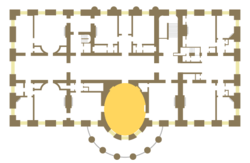
Location of the Yellow Oval Room on the second floor of the White House. A number of presidents used this as their private office or library.
-

The Yellow Oval Room about 1868 used as President Andrew Johnson's library. Note the bearskin chair on the right.
-

Exterior of the West Wing (circa 1910s), showing the curve of the Taft Oval Office.
-

President Hoover views West Wing fire ruins, January 15, 1930.
-
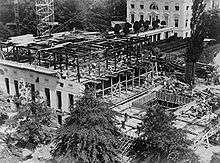
West Wing construction, 1934.
-

Exterior of the Oval Office as viewed from the South Lawn, July 15, 2006.
Modern Oval Office: 1934–present
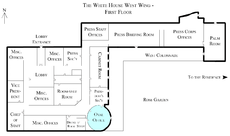

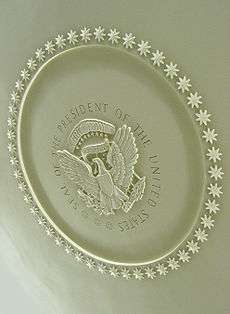
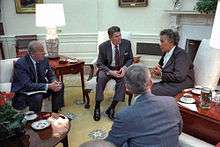
Dissatisfied with the size and layout of the West Wing, President Franklin D. Roosevelt engaged New York architect Eric Gugler to redesign it in 1933. To create additional space without increasing the apparent size of the building, Gugler excavated a full basement, added a set of subterranean offices under the adjacent lawn, and built an unobtrusive "penthouse" story. The directive to wring the most office space out of the existing building was responsible for its narrow corridors and cramped staff offices. Gugler's most visible addition was the expansion of the building eastward for a new Cabinet Room and Oval Office.[13]
The modern Oval Office was built at the West Wing's southeast corner, offering FDR, who was physically disabled and used a wheelchair, more privacy and easier access to the Residence. He and Gugler devised a room architecturally grander than the previous two rooms, with more robust Georgian details: doors topped with substantial pediments, bookcases set into niches, a deep bracketed cornice, and a ceiling medallion of the Presidential Seal. Rather than a chandelier or ceiling fixture, the room is illuminated by light bulbs hidden within the cornice that "wash" the ceiling in light.[14] In small ways, hints of Art Moderne can be seen, in the sconces flanking the windows and the representation of the eagle in the ceiling medallion. FDR and Gugler worked closely together, often over breakfast, with Gugler sketching the president's ideas. One notion resulting from these sketches that has become fixed in the layout of the room's furniture, is that of two high back chairs in front of the fireplace. The public sees this most often with the president seated on the left, and a visiting head of state on the right. This allowed FDR to be seated, with his guests at the same level, de-emphasizing his inability to stand. Construction of the modern Oval Office was completed in 1934.
Decoration
The basic Oval Office furnishings have been a desk in front of the three windows at the south end, a pair of chairs in front of the fireplace at the north end, a pair of sofas, and assorted tables and chairs. The Neoclassical mantel was made for the Taft Oval Office in 1909, and salvaged after the 1929 West Wing fire.[15] A tradition of displaying potted Swedish ivy (Plectranthus verticillatus) atop the mantel goes back to the administration of John F. Kennedy, and the current plants were rooted from the original plant. The tall-case clock, commonly called a grandfather clock, was built in Boston by John Seymour, c. 1795–1805, entered the White House Collection in the 1970s, and has adorned every Oval Office since Gerald Ford's.
The carpet of the Oval Office bears the Seal of the President. President Harry S. Truman's oval carpet was the first to incorporate the presidential seal. In Truman's carpet, the seal was represented monochromatically through varying depths of the cut pile. His carpet was used in the Eisenhower and Kennedy administrations. In recent years most administrations have created their own rug, working with an interior designer and the Curator of the White House. As part of her overall restoration of the White House, Jacqueline Kennedy had a redecoration of the Oval Office begun on November 21, 1963, when she accompanied President John F. Kennedy on a trip to Texas. The next day, November 22, a new carpet was installed just as the Kennedys were making their way through Dallas and the President was assassinated.[16]
Desks
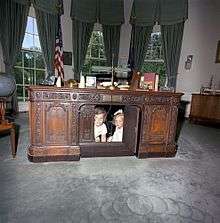
Six desks have been used in the Oval Office by U.S. Presidents. The Theodore Roosevelt desk was used there by seven presidents – most recently by Dwight Eisenhower – and by Theodore Roosevelt in his non-oval office.
The next most-popular is the Resolute Desk, so named because it was made from the timbers of the British frigate HMS Resolute. The ship had been frozen in Arctic ice and abandoned but was later found and freed by American seamen. It was refurbished and presented as a gift from the United States to Queen Victoria in 1856. When the ship was decommissioned from the British Navy in 1879, Queen Victoria ordered twin desks made from its timbers, keeping one and presenting the other as a gift to President Rutherford B. Hayes in 1880. President Franklin D. Roosevelt ordered a kneehole panel with the Presidential Seal added, but work was not completed until after his 1945 death in office. First Lady Jacqueline Kennedy had the desk restored, and she was the first to place it in the Oval Office. Following the 1963 assassination of President John F. Kennedy, the desk toured the country as part of a traveling exhibit for the Kennedy Presidential Library and was then lent to the Smithsonian Institution. President Jimmy Carter brought the desk back to the Oval Office in the 1970s. Since then, Presidents Ronald Reagan, Bill Clinton, George W. Bush, and Barack Obama have also used it as their Oval Office desk.
When not in use in the Oval Office, a desk is often placed in the adjacent Oval Office Study, in the White House, or is used by the vice-president.
Artwork


Art may be selected from the White House collection, or may be borrowed from museums or individuals for the length of an administration.
Most presidents have hung a portrait of George Washington – usually the Rembrandt Peale "Porthole" portrait or the Charles Willson Peale three-quarter-length portrait – over the mantel at the north end of the room. A portrait of Andrew Jackson by Thomas Sully hung in Lyndon Johnson's office, and in Ronald Reagan's, George H. W. Bush's and Bill Clinton's. A portrait of Abraham Lincoln by George Henry Story hung in George W. Bush's office, and continues in Barack Obama's. Three landscapes/cityscapes by minor artists – The City of Washington from Beyond the Navy Yard by George Cooke, Eastport and Passamaquoddy Bay by Victor de Grailly, and The President's House, a copy after William Henry Bartlett – have adorned the walls in multiple administrations. The Avenue in the Rain by Childe Hassam and Statue of Liberty by Norman Rockwell flanked the Resolute Desk in Bill Clinton's office, and do the same in Barack Obama's.
Statuettes, busts, heads, and figurines are frequently displayed in the Oval Office. Abraham Lincoln has been the most common subject, in works by sculptors Augustus Saint-Gaudens, Gutzon Borglum, Adolph Alexander Weinman, Leo Cherne and others. In recent administrations, traditional busts of George Washington, Thomas Jefferson or Benjamin Franklin have given way to heads of Franklin D. Roosevelt, Harry S. Truman or Dwight Eisenhower. Western bronzes by Frederic Remington have been frequent choices: Harry S. Truman displayed Fired On; Lyndon Johnson displayed The Bronco Buster, as did Gerald Ford, Jimmy Carter, Ronald Reagan, Bill Clinton, George W. Bush and Barack Obama. Presidents Reagan and Bush added its companion piece, Rattlesnake.
President Harry S. Truman displayed works related to his home state of Missouri, illustrations of biplanes, and models of jet-airplanes. He hung a large photograph of the White House portrait of Franklin D. Roosevelt, under whom he had served as Vice-President, who died in office in 1945. President Dwight Eisenhower filled the office walls with landscape paintings. President John F. Kennedy surrounded himself with paintings of naval battles from the War of 1812, photographs of sailboats, and ship models. President Lyndon Johnson installed sconces on either side of the mantel, and added the office's first painting by a woman artist, Franklin D. Roosevelt by Elizabeth Shoumatoff. President Richard Nixon tried three different George Washington portraits over the mantel, and hung a copy of Earthrise – a photograph of the earth taken from the moon's orbit during the Apollo 8 mission – beside his desk. President Gerald Ford displayed tasteful, conservative works; paintings that remained mostly in place through the administrations of Jimmy Carter and Ronald Reagan. President George H. W. Bush added luminist landscapes. President Bill Clinton chose the Childe Hassam and Norman Rockwell paintings mentioned above, along with Waiting for the Hour by William T. Carlton,[17] a genre painting showing African-Americans gathered in anticipation of the Emancipation Proclamation going into effect. President George W. Bush mixed traditional works with paintings by Texas artists and Western sculptures. Following the September 11, 2001 attacks, British Prime Minister Tony Blair lent him a bust of Winston Churchill, who had guided Great Britain through World War II. President Barack Obama honors Abraham Lincoln with the portrait by Story, a bust by Augustus Saint-Gaudens, and a copy of the Emancipation Proclamation. Below the proclamation is a bust of Martin Luther King, Jr. by Charles Alston,[18] and in the nearby bookcase is a program from the August 28, 1963 March on Washington, at which Dr. King gave his "I Have a Dream Speech."
Redecoration
A tradition evolved in the latter part of the twentieth century of each new administration redecorating the office to the President's liking. A new administration usually selects an oval carpet, new drapery, the paintings on the walls, and some furniture. Most incoming presidents continue using the rug of their predecessor until their new one is installed. The retired carpet very often is then moved to the presidential library of the president for whom it was made.
The redecoration of the Oval Office is usually coordinated by the First Lady's office in the East Wing, working with an interior designer and the White House Curator.
Alterations
Since the present Oval Office's construction in 1934 during the administration of President Franklin Delano Roosevelt the room has remained mostly unchanged architecturally. More than any president, FDR left an impression on the room and its use. Doors and window frames have been modified slightly. A screen door on the east wall was removed after the installation of air conditioning. President Lyndon B. Johnson's row of wire service Teletype machines on the southeast wall required cutting plaster and flooring to accommodate wiring. The Georgian style plaster ornament has been cleaned to remove accumulated paint, and a series of electrified wall sconces have come and gone.
Though some presidents have chosen to do day-to-day work in a smaller study just west of the Oval Office, most use the actual Oval Office for work and meetings. Traffic from the large numbers of staff, visitors, and pets over time takes its toll. There have been four sets of flooring in the Oval Office. The original floor was made of cork installed over soft wood; however, President Dwight D. Eisenhower was an avid golfer and damaged the floor with his golf spikes. Johnson had the floor replaced in the mid-1960s with wood-grain linoleum. In 1982, President Ronald Reagan had the floor replaced with quarter sawn oak and walnut, in a cross parquet pattern similar in design to Eric Gugler's 1933 sketch, which had never been installed. In August 2005, the floor was replaced again under President George W. Bush, in exactly the same pattern as the Reagan floor.
Conservation
In the late 1980s a comprehensive assessment of the entire house, including the Oval Office, was made as part of the National Park Service's Historic American Buildings Survey (HABS).[19] Detailed photographs and measured drawings were made documenting the interior and exterior and showing even slight imperfections. A checklist of materials and methods was generated for future conservation and restoration.
Dimensions
| Dimensions | US | SI |
|---|---|---|
| Major axis (north-south) | 35′10″ | 10.9 m |
| Minor axis (east-west) | 29′ | 8.8 m |
| Eccentricity | 0.59 | 0.59 |
| Height | 18′6″ | 5.6 m |
| Line of rise (the point at which the ceiling starts to arch) | 16′7″ | 5.0 m |
| Approximate circumference | 102′5″ | 31.2 m |
| Approximate area | 816.2 sq ft | 75.8 sq m |
The ratio of the major axis to the minor axis is approximately 21:17 or 1.24.
-

John F. Kennedy's children visit the Oval Office
-

The Oval Office during the presidency of Gerald Ford
-

President Richard M. Nixon and Bob Hope play golf in the Oval Office, a tradition harking back to the tenure of Lyndon Baines Johnson
-

President George W. Bush chose a more muted color palette than his predecessor, using shades of taupe, celadon and navy.
-

One of many hand-shake photos in front of the fireplace. President George W. Bush sitting to the viewer's right, the guest (Paul Kagame, President of Rwanda) to the left. One of the rare images where there is fire in the fireplace. March 2003.
Taft Oval Office, 1909–1933
| President | Image | Designer | Furnishings | Artwork | Notes |
|---|---|---|---|---|---|
| William Howard Taft 1909-1913 |
 |
Nathan C. Wyeth, 1909 | Marble Neoclassical mantel Bookcases with glass doors Lighting fixtures by E. F. Caldwell & Co.[20] Walls covered in green burlap Skylight Theodore Roosevelt desk Green drapery Green rug 2 leather "Davenport" sofas Leather armchairs Side chairs covered in leather |
 President Taft used the desk and furniture from President Roosevelt's office. | |
| Woodrow Wilson 1913-1921 |
 |
President Wilson rarely used the Oval Office, preferring to work in the Treaty Room.[21] | |||
| Warren G. Harding 1921-1923 |
 |
President Harding died in office on August 2, 1923. This photo, taken on the day of his funeral, shows a mourning crepe tied to the desk chair and blotter. | |||
| Calvin Coolidge 1923-1929 |
 |
President Coolidge's first official photograph, taken August 15, 1923. | |||
| Herbert Hoover 1929-1933 |
 |
Before fire: Theodore Roosevelt desk After fire: Hoover desk[22] Art Moderne-style sconces 6 cane-back armchairs Upholstered furniture |
President Hoover rebuilt the West Wing after the December 24, 1929 fire. He installed air-conditioning, and replaced the Oval Office's Colonial-Revival lighting fixtures with Art Moderne ones. He replaced the leather sofas and chairs with upholstered furniture, and added the 6 cane-back armchairs that are still used in the modern Oval Office. | ||
| Franklin D. Roosevelt 1933-1945 |
 |
Hoover desk | Note the Art Moderne sconces in this 1933 photo. President Roosevelt moved the marble mantel, 2 of the sconces, the rug, drapery, desk, and furniture to the modern Oval Office. |
Modern Oval Office, 1934–present
| President | Image | Designer | Furnishings | Artwork | Notes |
|---|---|---|---|---|---|
| Franklin D. Roosevelt 1933-1945 |
 |
Eric Gugler, 1934 | Marble mantel (from prior Oval Office) 2 sconces (from prior Oval Office) Hoover desk Green drapery Green rug Arched-back desk chair Arched-back armchairs (against the wall) "Lawson" sofa (against the wall) 6 cane-back armchairs |
George Washington by Rembrandt Peale Prints of the Hudson Valley Ship models |
George Washington by Rembrandt Peale_-_Google_Art_Project.jpg) Oval Office replica at Franklin D. Roosevelt Presidential Library and Museum.  |
| Harry S. Truman 1945-1953 |
 |
Theodore Roosevelt desk Gray drapery Blue-gray rug with the Presidential Seal Television set |
George Washington by Rembrandt Peale George Washington by Luis Cadena (gift of Ecuador)[23] Simón Bolívar by Tito Salas (gift of Venezuela)[24] José de San Martín, copy after Jean Baptiste Madou (gift of Argentina) USS Constitution by Gordon Grant Missouri State Seal plaque Fired On by Frederic Remington Equestrian Statue of Andrew Jackson by Charles Keck Photograph of Portrait of Franklin Delano Roosevelt by Frank O. Salisbury Jet-airplane models |
  Oval Office replica at Harry S. Truman Presidential Library. | |
| Dwight D. Eisenhower 1953-1961 |
 |
Theodore Roosevelt desk Truman drapery Truman rug |
Landscape paintings Seated Lincoln by Gutzon Borglum |
 | |
| John F. Kennedy 1961-1963 |
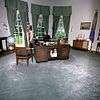 |
Stéphane Boudin, 1963 | Resolute desk White drapery Red rug Rocking chair 2 white sofas (not against the wall) Round coffee table, with phone attached Replaced sconces with brass lanterns |
USS United States vs. HMS Macedonian by Thomas Birch[25] Paintings of naval battles Photographs of sailboats Ship models |
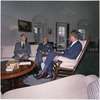 First Lady Jacqueline Kennedy restored the Resolute desk. Redecoration of the Oval Office was nearing completion at the time of JFK's assassination.[26] |
| Lyndon B. Johnson 1963-1969 |
 |
Johnson desk[27] Truman rug Kennedy drapery Cabinet for Teletype Banquette with three televisions Kennedy rocking chair Kennedy sofas Round coffee table, with phone in drawer Federal-style tall-case clock Replaced brass lanterns with brass sconces Covered floor with wood-grained linoleum |
George Washington by Gilbert Stuart Andrew Jackson by Thomas Sully Thomas Jefferson by Gilbert Stuart Franklin D. Roosevelt by Elizabeth Shoumatoff[28] The Bronco Buster by Frederic Remington Bust of Lyndon B. Johnson (1966) by Jimilu Mason[29] |
 | |
| Richard Nixon 1969-1974 |
 |
Wilson desk Yellow drapery Royal blue rug |
1st. George Washington by Gilbert Stuart 2nd. George Washington by Rembrandt Peale 3rd. George Washington by Charles Willson Peale The President's House, copy after William Henry Bartlett Bust of Abraham Lincoln by Leo Cherne Bird figurines by Edward Marshall Boehm Earthrise (photograph of the earth from the moon's orbit) |
 President Nixon used an office in the Old Executive Office Building as his primary workspace. First Lady Pat Nixon designed the Oval Office's royal blue rug. | |
| Gerald Ford 1974-1977 |
 |
Wilson desk Red drapery Yellow floral rug 2 yellow Queen Anne-style armchairs 2 yellow wing chairs 2 striped sofas Seymour tall-case clock Removed the brass sconces |
George Washington by Charles Willson Peale The President's House, copy after William Henry Bartlett Eastport and Passamaquoddy Bay by Victor de Grailly The City of Washington from Beyond the Navy Yard by George Cooke[30] Benjamin Franklin by Charles Willson Peale Standing Lincoln by Adolph Alexander Weinman The Bronco Buster by Frederic Remington |
 | |
| Jimmy Carter 1977-1981 |
 |
1977 | Resolute desk Ford drapery Ford rug Placed the Ford sofas back-to-back |
George Washington by Charles Willson Peale. The President's House, copy after William Henry Bartlett Eastport and Passamaquoddy Bay by Victor de Grailly The City of Washington from Beyond the Navy Yard by George Cooke Bust of Benjamin Franklin by Jean-Antoine Houdon Bust of George Washington by Hiram Powers Bust of Thomas Jefferson by Jean-Antoine Houdon The Bronco Buster by Frederic Remington Bust of Harry S. Truman by Charles Keck Ship model |
|
| Ronald Reagan 1981-1989 |
 |
Ted Graber, 1981[32] Ted Graber, 1988 |
Resolute desk Ford drapery Replaced the wood floor[33] |
George Washington by Charles Willson Peale. The President's House, copy after William Henry Bartlett Eastport and Passamaquoddy Bay by Victor de Grailly The City of Washington from Beyond the Navy Yard by George Cooke Andrew Jackson by Thomas Sully The Bronco Buster by Frederic Remington Rattlesnake by Frederic Remington |
 First Lady Nancy Reagan designed the rug.[34] |
| George H. W. Bush 1989-1993 |
 |
Mark Hampton | C&O desk Pale blue drapery Pale blue rug |
George Washington by Rembrandt Peale The President's House, copy after William Henry Bartlett Rutland Falls, Vermont by Frederic Edwin Church The Three Tetons by Thomas Moran Andrew Jackson by Thomas Sully Ship model |
 |
| Bill Clinton 1993-2001 |
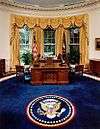 |
Kaki Hockersmith | Resolute desk Yellow drapery Navy blue rug |
George Washington by Rembrandt Peale The Avenue in the Rain by Childe Hassam Statue of Liberty by Norman Rockwell The City of Washington from Beyond the Navy Yard by George Cooke Waiting for the Hour by William Tolman Carlton Andrew Jackson by Thomas Sully The Thinker by Auguste Rodin The Bronco Buster by Frederic Remington Appeal to the Great Spirit by Cyrus Dallin Bust of Abraham Lincoln by Robert Berks Bust of Franklin D. Roosevelt by Jo Davidson |
 |
| George W. Bush 2001-2009 |
 |
Ken Blasingame, 2001 | Resolute desk Gold drapery "Sunbeam" rug Replaced the wood floor |
George Washington by Rembrandt Peale. A Charge to Keep by W. H. D. Koerner[35] Rio Grande by Tom Lea[36] Near San Antonio by Julian Onderdonk[37] Chili Queens at the Alamo by Julian Onderdonk[38] Cactus Flower by Julian Onderdonk[39] Abraham Lincoln by George Henry Story The Bronco Buster by Frederic Remington Rattlesnake by Frederic Remington Bust of Dwight D. Eisenhower by Nison Tregor Bust of Abraham Lincoln by Augustus Saint-Gaudens Bust of Winston Churchill (lent by British Prime Minister Tony Blair) |
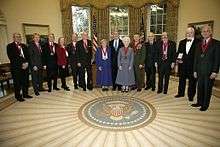  Oval Office replica at George W. Bush Presidential Center. |
| Barack Obama 2009–present |
 |
Michael S. Smith, 2010 | Resolute desk Red drapery Taupe rug with quotes in border Striped wallpaper |
George Washington by Rembrandt Peale The Avenue in the Rain by Childe Hassam Statue of Liberty by Norman Rockwell The Three Tetons by Thomas Moran Abraham Lincoln by George Henry Story Cobb's Barns, South Truro by Edward Hopper Burly Cobb's House, South Truro by Edward Hopper The Bronco Buster by Frederic Remington Bust of Abraham Lincoln by Augustus Saint-Gaudens Bust of Martin Luther King, Jr. by Charles Alston Copy of the Emancipation Proclamation |
 |
References
- ↑ Why is the Oval Office oval? from White House Historical Association.
- ↑ "Recollections of Judge John B. Wallace," Pennsylvania Magazine of History and Biography, vol. 2 (1878), p. 175.
- ↑ David McCullough, John Adams (New York: Simon & Schuster, 2001), p. 490.
- ↑ A Window with Its Place in History Philadelphia Inquirer, May 9, 2007.
- ↑ Photos of the archaeology.
- ↑ "There can be little doubt that in Washington's bow can be found the seed that was later to flower in the oval shape of the Blue Room." William Seale, The President's House, A History (Washington, D. C., 1986), 8.
- ↑ William Seale, "James Hoban: Builder of the White House," in White House History no. 22 (Spring 2008), pp. 8–12.
- ↑ Architect Daniel Burnham recommended that it be erected on the opposite side of Pennsylvania Avenue in Lafayette Park, to assure that it would remain a temporary building. Seale, The President's House, p. 664.
- ↑ The greenhouses were disassembled and relocated.
- ↑ William Allman, White House Curator, "Oval Office Tour, December 1, 2008," CSPAN documentary, 14:45.
- ↑ Seale, The President's House, p. 895.
- ↑ "The White House: Inside America's Most Famous Home" - CSPAN Documentary
- ↑ Seale, The President's House, pp. 946-49.
- ↑ Seale, The President's House, p. 948.
- ↑ William Allman, White House Curator, "Oval Office Tour, December 1, 2008," CSPAN documentary, 00:45.
- ↑ Brandus, Paul (September 2015). Under This Roof The White House and the Presidency--21 Presidents, 21 Rooms, 21 Inside Stories. Globe Pequot Press / Lyons Press. p. 208. ISBN 978-1-4930-0834-6.
- ↑ Waiting for the Hour from Virginia Memory.
- ↑ "Clinton announces first image of a Black is on display at the White House". Jet. March 14, 2000. Retrieved July 24, 2013.
- ↑ Historic American Buildings Survey (HABS) No. DC-37, "White House, 1600 Pennsylvania Avenue, Northwest, Washington, District of Columbia, DC", 599 photos, 3 color transparencies, 41 measured drawings, 8 data pages, 35 photo caption pages
- ↑ Monkman, p. 198.
- ↑ Seale, The President's House, p. 812.
- ↑ After the fire, the president used "the great mahogany desk presented to Hoover by furniture makers in Grand Rapids." Seale, The President's House, p. 918.
- ↑ George Washington by Luis Cadena from White House Historical Association.
- ↑ Simón Bolívar by Tito Salas from Harry S. Truman Presidential Library.
- ↑ USS United States vs. HMS Macedonian (1813) from Sotheby's Auction, May 22, 2008.
- ↑ Kennedy Oval Office from White House Museum. Scroll to bottom for photo.
- ↑ President Johnson used the same desk he had used as a U.S. Senator and Vice-President.
- ↑ FDR by Elizabeth Shoumatoff from White House Historical Association.
- ↑ Bust of Lyndon B. Johnson from U.S. Senate Vice-Presidential Bust Collection.
- ↑ City of Washington from Wikimedia Commons.
- ↑ Seymour tall-case clock from White House Historical Association.
- ↑ "Oval Office has new face for Reagan," from Los Angeles Herald-Examiner, September 5, 1981.
- ↑ Oval Office Flooring from HuffPostLive.
- ↑ "Easy come, easy go," from Chicago Tribune.
- ↑ A Charge to Keep from Wikimedia Commons. Lent by the Bush Family.
- ↑ "Mrs. Bush's Remarks for 100th Anniversary of the West Wing Symposium". - White House Historical Association. - November 13, 2002. - | Light from the Sky: A Tom Lea Retrospective, 1907–2001. - Mid-America Arts Alliance. - (Adobe Acrobat *.PDF document). - Retrieved: July 5, 2008 Lent by the El Paso Museum.
- ↑ Lent by the San Antonio Museum of Art."Julian Onderdonk" from Questroyal Fine Art, LLC.
- ↑ Lent by the Witte Museum.
- ↑ Lent by the Witte Museum.
- ↑ "Bush weaves Rug story into many an occasion," from The Washington Post, March 7, 2006.
Further reading
- Portions of this article are based on public domain text from the White House.
- The White House: An Historic Guide. White House Historical Association and the National Geographic Society: 2001. ISBN 0-912308-79-6.
- Abbott James A., and Elaine M. Rice. Designing Camelot: The Kennedy White House Restoration. Van Nostrand Reinhold: 1998. ISBN 0-442-02532-7.
- Clinton, Hillary Rodham. An Invitation to the White House: At Home with History. Simon & Schuster: 2000. ISBN 0-684-85799-5.
- Monkman, Betty C. The White House: The Historic Furnishing & First Families. Abbeville Press: 2000. ISBN 0-7892-0624-2.
- Ryan, William and Desmond Guinness. The White House: An Architectural History. McGraw Hill Book Company: 1980. ISBN 0-07-054352-6.
- Seale, William. The President's House. White House Historical Association and the National Geographic Society: 1986. ISBN 0-912308-28-1.
- Seale, William, The White House: The History of an American Idea. White House Historical Association: 1992, 2001. ISBN 0-912308-85-0.
- West, J.B. with Mary Lynn Kotz. Upstairs at the White House: My Life with the First Ladies. Coward, McCann & Geoghegan: 1973. SBN 698-10546-X.
External links
| Wikimedia Commons has media related to Oval Office. |
| Wikiquote has quotations related to: Oval Office |
- Oval Office historical photo essay
- Pictures of the Oval Office during different presidencies (1909–2005)
- Washington Post: "Inside the Real West Wing"
- Oval Office and Presidential desks
- White House Museum online tour: the Oval Office
- The Oval Office on Whitehouse.gov
- Google Sketchup 3D Model
- 2010 Oval Office Makeover
- An Office Fitted for a President — slideshow by The New York Times
- Quality West Wing — includes an exact replica of the Oval Office, in Corona, California
Coordinates: 38°53′51″N 77°02′15″W / 38.8974°N 77.0374°W


